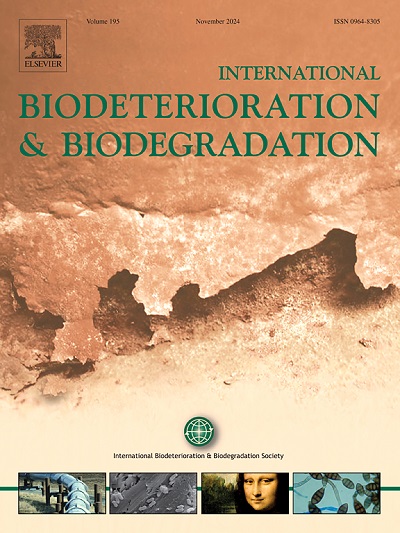Niche differentiation of denitrifying anaerobic methane oxidation bacteria and archaea in the permafrost peatlands
IF 4.1
2区 环境科学与生态学
Q2 BIOTECHNOLOGY & APPLIED MICROBIOLOGY
International Biodeterioration & Biodegradation
Pub Date : 2025-02-01
DOI:10.1016/j.ibiod.2024.105990
引用次数: 0
Abstract
The anaerobic oxidation of methane (AOM) coupled to either nitrite or nitrate reduction (nitrite or nitrate-DAMO) is a process connecting global nitrogen and carbon cycles. Permafrost peatlands are important natural sources of methane, and climate warming is accelerating permafrost thaw, resulting in changes in water table and vegetation communities that are dramatically reshaping microbial-mediated methane oxidation processes, potentially creating strong positive peatland-climate feedbacks, while the ecology of DAMO bacteria and archaea in peatland soils is poorly understood. Herein, the diversity, abundance, phylogeny, and potential activity of DAMO bacteria and archaea were explored using molecular techniques and stable isotope tracing in three typical peatlands of the Greater Khingan Mountains permafrost regions. The results revealed the co-existence of DAMO bacteria and archaea, with notable variations in community structures across different peatlands, while the vertical distribution within soil profiles remained relatively stable. These variations were mainly affected by factors such as water content, total organic carbon, nitrite, and nitrate in soil. The potential activity and abundance suggested that DAMO bacteria were predominantly found in the middle soil layers, whereas DAMO archaea were more abundant in the bottom layers. Furthermore, the diversity, potential activity, and abundance of DAMO bacteria generally declined along the forest-peatland ecotone, whereas DAMO archaea exhibited an increasing trend. Partial least squares path modeling (PLS-PM) and correlation analyses revealed strong associations between DAMO activities and the abundances of the pmoA and mcrA genes, in addition to substrate availability. The relative contribution of nitrite-DAMO to the total CH4 oxidation was 16.77%, slightly higher than that of nitrate-DAMO at 13.23%, with both contributing more significantly than AOM coupled to iron oxide reduction (Fe-AOM) at 8.65%, demonstrating that AOM are important processes for mitigating CH4 emissions in peatlands. This research contributes to a better understanding of the biogeochemical cycling of CH4 in permafrost peatlands and broaden our insight into the environmental significance of DAMO microorganisms.
求助全文
约1分钟内获得全文
求助全文
来源期刊
CiteScore
9.60
自引率
10.40%
发文量
107
审稿时长
21 days
期刊介绍:
International Biodeterioration and Biodegradation publishes original research papers and reviews on the biological causes of deterioration or degradation.

 求助内容:
求助内容: 应助结果提醒方式:
应助结果提醒方式:


